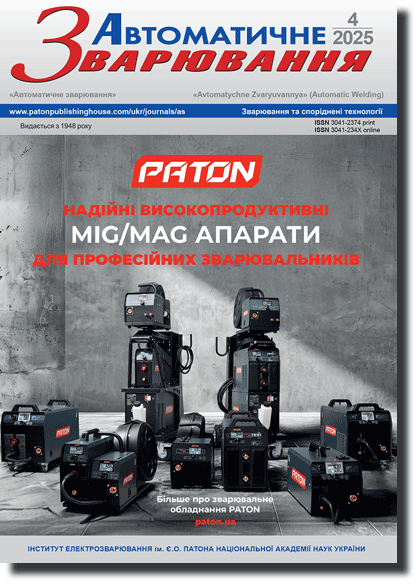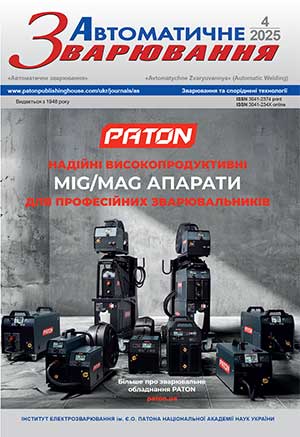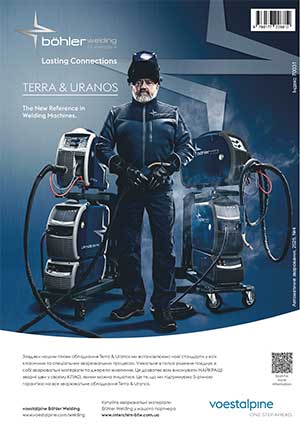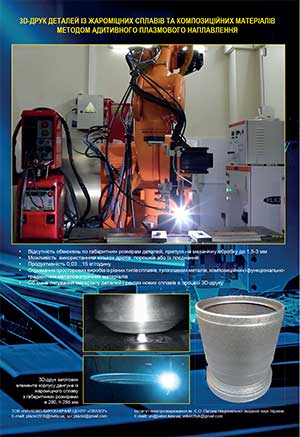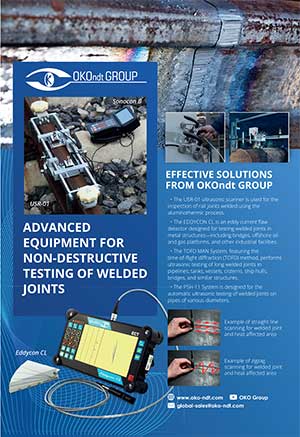| 2025 №04 (02) |
DOI of Article 10.37434/as2025.04.03 |
2025 №04 (04) |
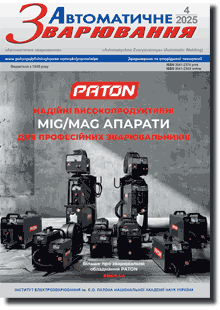
"Avtomatychne Zvaryuvannya" (Automatic Welding), #4, 2024, pp. 19-24
The effect of modes of electron beam processing of powder blanks from vk8 alloy on formation of the microstructure and properties of sintered products
M.O. Sysoiev1, V.M. Nesterenkov1, V.M. Bondar2, H.P. Kysla3
1E.O. Paton Electric Welding Institute of the NAS of Ukraine 11 Kazymyr Malevych Str., 03150, Kyiv, Ukraine. E-mail: sysoiev.maksym@tve.com.ua2East Ukrainian Volodymyr Dahl National University. 17 John Paul II Str., 01042, Kyiv, Ukraine. E-mail: vovabondar2896@gmail.com
3PlasmaTec LLC. 18 Pravednykiv Svitu Str., 21036, Vinnytsia, Ukraine. E-mail: Kysla.halyna@tve.com.ua
The results of the study of the influence of the cooling rate on the structure and properties of the WC-8Co hard alloy obtained by the electron beam sintering method are presented. The use of an electron beam provides high controllability of the heat treatment processes, which allows regulating the cooling rate of hard alloy samples. The tungsten carbide powder obtained by PlasmaTek LLC by a chemical method from secondary raw materials was used in the paper. The presence of two phases - tungsten carbide and a cobalt β-based solid solution was established by metallographic and X-ray analysis methods. There is no η-phase, free carbon or pores in the structure. It is shown that tungsten carbide crystals grow with an increase in cooling time. In terms of hardness and crack resistance, hard alloys obtained by the electron beam sintering method are not inferior to hard alloys obtained by the traditional technologies. 16 Ref., 2 Tabl., 7 Fig.
Keywords: hard alloy, electron beam sintering, tungsten carbide, cooling rate, grain size
Received: 28.04.2025
Received in revised form: 03.06.2025
Accepted: 29.07.2025
References
1. Upadhyaya, G.S. (2001) Materials science of cemented carbides - an overview. Materials & Design, 22(6), 483-489. https://doi.org/10.1016/S0261-3069(01)00007-32. Zak Fang, Xu Wang, Taegong Ryu et al. (2009) Synthesis, sintering and mechanical properties of nanocrystallaine cemented tungsten carbide - a review. International J. of Refractory Metals and Hard Materials, 27(2), 288-299. https://doi.org/10.1016/j.ijrmhm.2008.07.011
3. Falkovsky, V.A., Klyachko, L.I. (2005) Hard alloys. Moscow, Publish. House «Ruda i Metally» [in Russian]
4. Kharchenko, O.V., Prokopiv, M.M., Serdyuk, Yu.D. (2010) Structure of hard alloys of the WC Co group after aggregation in a gaseous medium. Sverkhtviordye Materialy, 2, 96-98 [in Ukrainian].
5. Bondarenko, V.P., Pavlotskaya, E.G. (1995) Sintering of tungsten hard alloys in a precision-controlled gas environment. Kyiv, Naukova Dumka [in Russian].
6. Chen, H., Zwang, D., Li, Y., Chen, J. (2001) High performance sinter - HIP for hard metals. In: Proc. 15 Intern. Plansee Seminar, Reutte, Austria, Vol. 2, 180-188.
7. Chongbin Wei, Xiaoyan Song, Shixian Zhao et al. (2010) In-situ synthesis of WC-Co composite powder and densification by sinter-HIP. International J. of Refractory Metals and Hard Materials, 28(5), 567-571. https://doi.org/10.1016/j.ijrmhm.2010.04.002
8. Kui Liu, Zhenhua Wang, Zengbin Yin et al. (2018) Effect of Co content on microstructure and mechanical properties of ultrafine grained WC-Co cemented carbide sintered by spark plasma sintering. Ceramics International, 44(15), 18711-18718. https://doi.org/10.1016/j.ceramint.2018.07.100
9. Breval, E., Cheng, J.P., Agrawal, D.K. et al. (2005) Comparison between microwave and conventional sintering of WC/Co composites. Materials Science and Engineering: A, 391(1-2), 285-295. https://doi.org/10.1016/j.msea.2004.08.085
10. Hwan-Cheol Kim, In-Jin Shon, In-Kyoon Jeong et al. (2007) Rapid sintering of ultrafine WC and WC - Co hard materials by high-frequency induction heated sintering and their mechanical properties. Metals and Materials International, 13, 39-45. https://doi.org/10.1007/BF03027821
11. Chaporova, I.N., Chernyavsky, K.S. (1975) Structure and properties of sintered hard alloys. Moscow, Metallurgiya [in Russian]
12. Farag, S., Konyashin, I., Ries, B. (2018) The influence of grain growth inhibitors on the microstructure and properties of submicron, ultrafine and nano-structured hardmetals - A review. International J. of Refractory Metals and Hard Materials, 77, 2-30. https://doi.org/10.1016/j.ijrmhm.2018.07.003
13. Atefeh, A., Javad, R.S.M., Zohreh, S., Filippo, B. (2020) A review of additive manufacturing of cermets. Additive Manufacturing, 33, 101130. https://doi.org/10.1016/j.addma.2020.101130
14. Yang,Y.K., Zhang, C.Q., Wang, D.Y. et al. (2020) Additive manufacturing of WC-Co hardmetals: a review. The International J. of Advanced Manufacturing Technology, 108, 1653-1673. https://doi.org/10.1007/s00170-020-05389-5
15. Loshak, M.G. (1986) Strength and durability of hard alloys. Kyiv, Naukova Dumka [in Russian].
16. Farag, S., Konyashin, I., Ries, B. (2018) The influence of grain growth inhibitors on the microstructure and properties of submicron, ultrafine and nano-structured hardmetals - A review. International J. of Refractory Metals and Hard Materials, 77, 12-30. https://doi.org/10.1016/j.ijrmhm.2018.07.003
Advertising in this issue:
To order the electronic version of the paper:
M.O. Sysoiev, V.M. Nesterenkov, V.M. Bondar, H.P. KyslaThe effect of modes of electron beam processing of powder blanks from vk8 alloy on formation of the microstructure and properties of sintered products
Automatic Welding №04 2025 p.19-24
The cost of article (pdf): 13 $, 12 €, 150 UAH (1 copy. )
fill in the form below:
The cost of subscription/purchase order journals or individual articles
| Journal/Currency | Annual Set | 1 issue printed |
1 issue |
one article |
| TPWJ/USD | 384 $ | 32 $ | 26 $ | 13 $ |
| TPWJ/EUR | 348 € | 29 € | 24 € | 12 € |
| TPWJ/UAH | 7200 UAH | 600 UAH | 600 UAH | 280 UAH |
| AS/UAH | 1800 UAH | 300 UAH | 300 UAH | 150 UAH |
| AS/USD | 192 $ | 32 $ | 26 $ | 13 $ |
| AS/EUR | 180 € | 30 € | 25 € | 12 € |
| SEM/UAH | 1200 UAH | 300 UAH | 300 UAH | 150 UAH |
| SEM/USD | 128 $ | 32 $ | 26 $ | 13 $ |
| SEM/EUR | 120 € | 30 € | 25 € | 12 € |
| TDNK/UAH | 1200 UAH | 300 UAH | 300 UAH | 150 UAH |
| TDNK/USD | 128 $ | 32 $ | 26 $ | 13 $ |
| TDNK/EUR | 120 € | 30 € | 25 € | 15 € |
AS = «Automatic Welding» - 6 issues per year;
TPWJ = «PATON WELDING JOURNAL» - 12 issues per year;
SEM = «Electrometallurgy Today» - 4 issues per year;
TDNK = «Technical Diagnostics and Non-Destructive Testing» - 4 issues per year.





